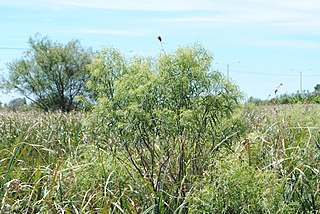Harold Ernest Robinson was an American botanist and entomologist.

Eupatorieae is a tribe of over 2000 species of plants in the family Asteraceae. Most of the species are native to tropical, subtropical, and warm temperate areas of the Americas, but some are found elsewhere. Well-known members are Stevia rebaudiana, a number of medicinal plants (Eupatorium), and a variety of late summer to autumn blooming garden flowers, including Ageratum (flossflower), Conoclinium (mistflower), and Liatris.

Distephanus is a genus of flowering plants in the family Asteraceae. It is described by American botanist Harold E. Robinson as having over 40 species and by David Mabberley as having only 34 species. These sources differ sharply in their description of the range of the genus. Robinson has it ranging throughout Africa and occurring also in India and China. Mabberley has it restricted to southeast Africa, Madagascar, and Mauritius. Plants of the World Online accepts 44 species native to sub-Saharan Africa, Madagascar, and south-central China.
Eremothamnus is a monotypic genus of shrubs in the family Asteraceae. Its only species is Eremothamnus marlothianus. It is native to the coastal desert of Namibia. It is a small shrub with spiny leaves.

Asteroideae is a subfamily of the plant family Asteraceae. It contains about 70% of the species of the family. It consists of several tribes, including Astereae, Calenduleae, Eupatorieae, Gnaphalieae, Heliantheae, Senecioneae and Tageteae. Asteroideae contains plants found all over the world, many of which are shrubby. There are about 1,135 genera and 17,200 species within this subfamily; the largest genera by number of species are Helichrysum (500–600) and Artemisia (550).

Vernonieae is a tribe of about 1300 species of plants in the aster family. They are mostly found in the tropics and warmer temperate areas, both in the Americas and the Old World. They are mostly herbaceous plants or shrubs, although there is at least one tree species, Vernonia arborea.

Bahianthus is a genus of flowering plants in the family Asteraceae.

Litothamnus is a genus of Brazilian flowering plants in the tribe Eupatorieae within the family Asteraceae.
Lorentzianthus is a monotypic genus of South American flowering plants in the boneset tribe within the sunflower family. The only known species is Lorentzianthus viscidus, native to Bolivia and Argentina.

Macvaughiella is a genus of Mesoamerican flowering plants in the tribe Eupatorieae within the family Asteraceae.
Matudina is a genus of flowering plants in the tribe Eupatorieae within the family Asteraceae.
Morithamnus is a genus of Brazilian flowering plants in the tribe Eupatorieae within the family Asteraceae.
Piqueriella is a genus of a Brazilian plants in the tribe Eupatorieae within the family Asteraceae. The genus contains a single described species, Piqueriella brasiliensis, found only in the State of Ceará in northeastern Brazil.
Platypodanthera is a genus of plants in the tribe Eupatorieae within the family Asteraceae.
Prolobus is a genus of flowering plants in the tribe Eupatorieae within the family Asteraceae.

Raulinoreitzia is a genus of South American plants in the tribe Eupatorieae within the family Asteraceae.
Revealia is a genus of Mexican plants in the tribe Eupatorieae within the family Asteraceae. The only known species is Revealia macrocephala, native to the Mexican State of Guerrero.

Santosia is a genus of Brazilian plants in the tribe Eupatorieae within the family Asteraceae.
Spaniopappus is a genus of Cuban plants in the tribe Eupatorieae within the family Asteraceae.
Heterocypsela is a genus of flowering plants in the family Asteraceae. It is native to Brazil.








